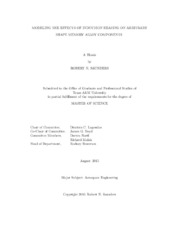| dc.description.abstract | The present work examines the effects of high frequency induction heating on shape memory alloy (SMA) components with arbitrary geometries. SMA actuators deliver high forces but are compact and reliable, making them ideal for consideration in aerospace applications. One disadvantage of these thermally driven actuators is their slow time response compared to conventional actuators. By subjecting the SMA component to electromagnetic fields such as those in induction heating enables the component to be heated in seconds. Although induction heating has recently been used to quickly heat SMA components, efforts to date have been purely empirical. This work presents the governing electromagnetic, thermo-mechanical, and constitutive equations needed to approach the problem in a computational manner. The derived equations are implemented in a finite element framework, which can be used for any 3-D arbitrary coil or SMA geometry and relative positioning. The time-harmonic electromagnetic equations are solved for the Joule heat power field, and then the energy and linear momentum equations are solved for the temperature and displacement fields. The 3-D model is implemented in the Abaqus Unified FEA software using a Python script approach and applied to two example cases: an SMA torque tube and an SMA bending beam actuator. The torque tube model is validated against induction heating experiments and agrees well. A study of flux concentrator properties and positions relative to the SMA actuator is shown, which demonstrates a reduction in the time required to heat. To accommodate future optimization work, the developed model is reduced from 3-D to an ordinary differential equation (ODE) in time for the case of a thin walled SMA torque tube, which assumes negligible gradients in all fields. The ODE solution agrees well with experiments and is able to capture the deviations from linearity due to latent heat effects. | en |


